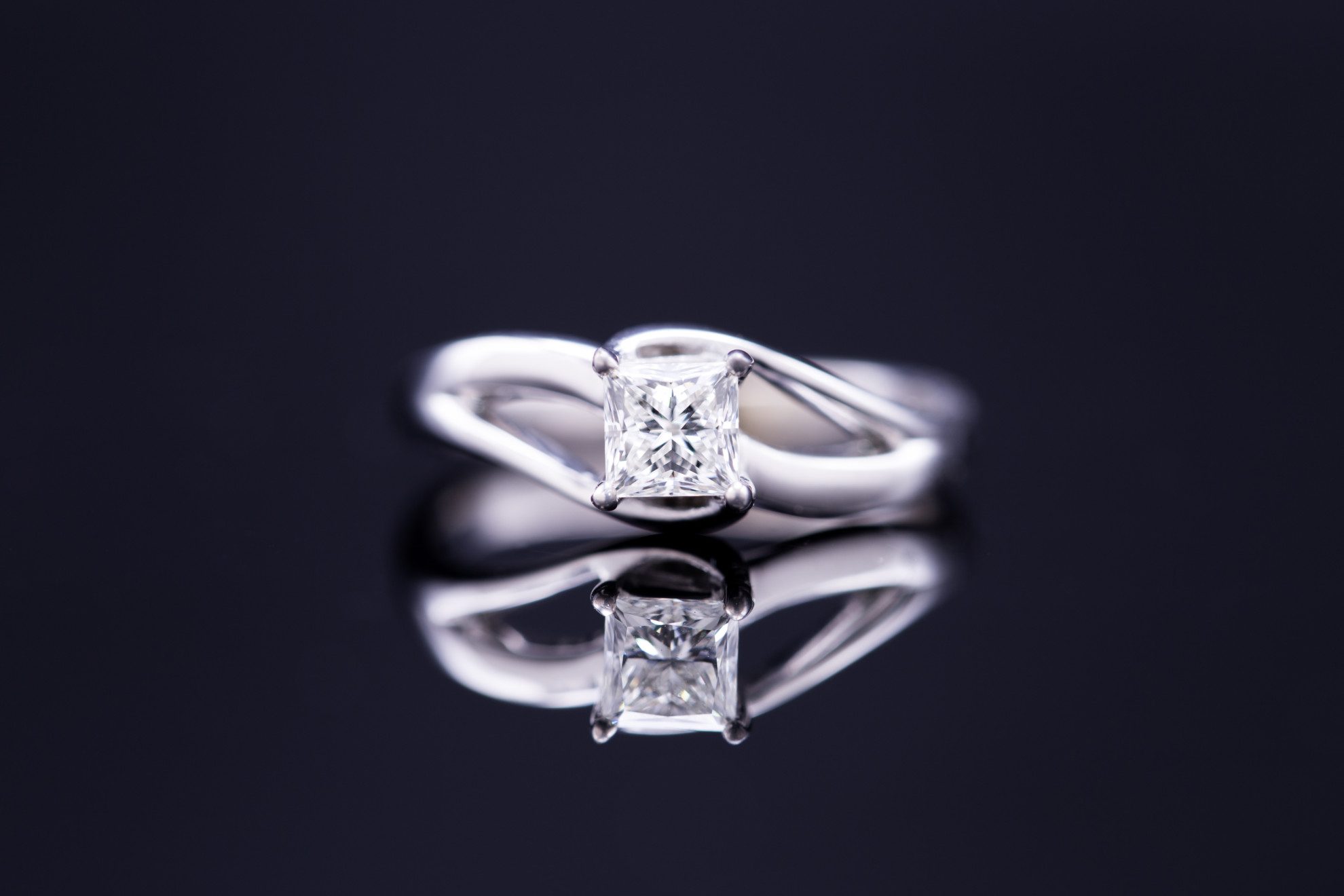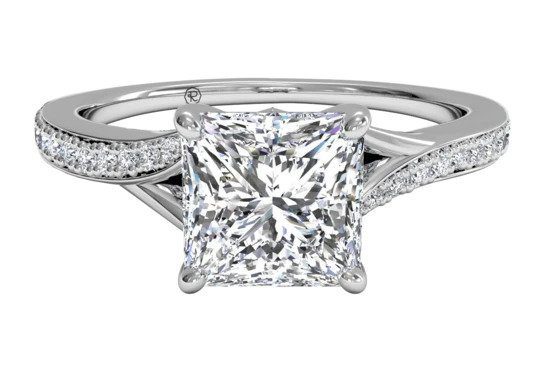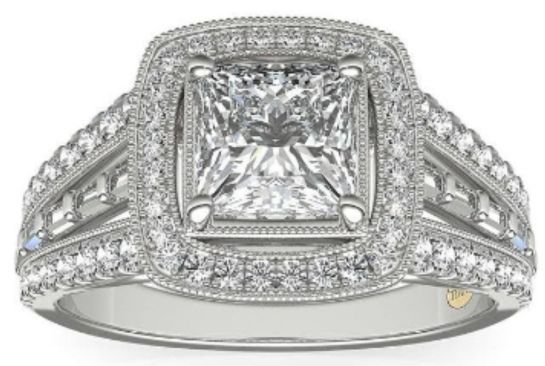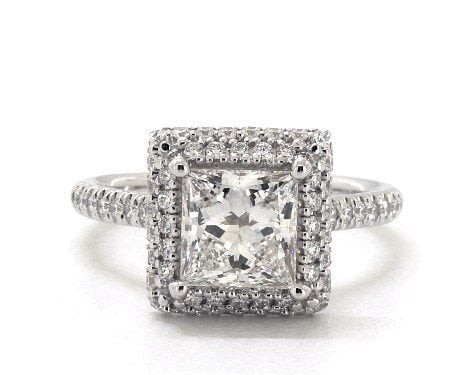Princess Cut Diamonds: The Ultimate Guide
Princess cut diamonds are an excellent alternative to rounds. Learn the 4Cs for princess cuts and how to choose the best diamonds for your engagement ring.
11 Minute Read
Learn the pros and cons of princess cuts and how to choose a high-quality natural or lab created stone for your engagement ring.
at CustomMade
What is a Princess Cut Diamond?
Princess cut diamonds appear square from the face-up, but are shaped like inverted pyramids with two to four chevron patterns on the underside of the cut. They are the second most sought-after diamond in engagement rings only behind round brilliant cut diamonds.
Pros and Cons of Princess Cut Diamonds
Ultimately, whether you choose a round or princess cut for your engagement ring may be a matter of personal style. However, you should also take some practical considerations into account.
Price
It's no secret that princess cut diamonds are less expensive than rounds. This is because of the octahedral shape of a rough diamond. When gem cutters split the rough in half, they can cut two princesses with minimal waste. (The two halves look like pyramids). In contrast, round-cut diamonds waste more rough, so they cost more than princess cuts. Based on this 1-ct ideal-cut, G color, VS2 clarity diamond, a princess cut diamond can cost 30% less than a round of equivalent carat weight.
Sparkle
Princess cuts can show exceptional brilliance. However, they still don't live up to the brilliance of round diamonds. No fancy cut can match their optimal light performance. So, while princess cuts can have great sparkle, they'll never sparkle better than an ideal round.
Size
If you compare a princess and a round diamond of the same carat weight, you'll see that the round will have a slightly larger face-up surface area. However, princess cuts can often appear larger, since they have such large diagonal measurements.
That said, you'll still be able to get a significantly larger princess cut than a round cut while staying within your engagement ring budget.
Durability
Since the corners of a princess cut diamond may snag, they're likely to chip. Their corners should always be protected with prongs to reduce the risk of damage to the stone. Although round diamonds can still chip, they don't have any weak points so prone to chipping.
Princess Cut Diamonds Engagement Ring Styles
Of course, you can't consider different diamond shapes without taking style into account. Although round diamonds are a standard, classic shape, princess cut diamonds are the most popular of the fancy shapes. They work well in many styles, including solitaire and three-stone engagement rings.
The brilliance and geometric shape of princess cuts make them a great choice for sleek modern styles.
at James Allen
However, princess cut diamonds can also work well in ornate vintage styles.
at CustomMade
Evaluating the Princess Cut
A diamond's sparkle comes primarily from the quality of its cut. Unfortunately, you'll find evaluating a princess cut a bit more difficult than evaluating a round. Most gemological laboratories don't grade the cut quality of fancy cuts, including princesses.
While the James Allen and Blue Nile websites do provide cut quality grades for princess cuts, these are less robust than those for rounds. Still, they make it possible to weed out some of the less impressive stones. Compare this "Good" cut to a "True Hearts" cut. There's no denying the difference!
If you're looking for an easy way to focus your search, filter the James Allen database for princesses with "True Hearts"-quality cuts only. Your results will show you princess cut diamonds that perform well. However, you might miss out on a deal by ruling out the next-best cut grades.
Anatomy of a Princess Cut
All fancy-cut diamonds have too many variations for standardized cut grades. Unlike the round brilliant, there's no set expectation for what a princess cut should look like. Princess cuts can differ by the pattern on the crown as well as the number of cuts on the pavilion. While neither impacts value or quality, you'll just prefer one to the other.
The crown of a princess — the part on the diamond that faces up when you look at it — can have either French corners or bezel corners. (Princess cuts with bezel corners have diamond-shaped facets extending from the table corners to the stone corners; those with French corners have star facets that point to the stone corners).
Since bezel corners are more durable, stick to this design unless you have a strong preference for French corners.
On the pavilion or underside of a princess cut, chevron shapes produce the diamond's brilliance. Princess cuts can have two, three, or four chevrons. Stones with two chevrons produce larger, bolder flashes of light and color, while four chevrons will scintillate more, but with smaller facets. Those with three chevrons create a middle ground.
Depth Percentage
When a diamond is cut too shallow or too deep, the light that enters the stone doesn't properly reflect back to your eye. When searching for a princess cut, limit the depth percentage to 65-75%.
Table Percentage
The table percentage describes how large the top facet is compared to the width of the diamond. Keeping the table to 75% and below will help you find a great princess.
A small minority of diamond dealers prefer a princess with a very small table, under 68%. If you prefer small tables, prepare to do some searching, as these are less common than larger tables.
Length-to-Width Ratio
For a square princess cut, stick to length-to-width ratios (L/W) of 1.05 and below. Above 1.05, the diamond appears off-shape.
Rectangular princess cut diamonds should be sufficiently rectangular that they don't simply appear off-shape. At a L/W ratio of at least 1.2, the diamond will appear rectangular.
Girdle Thickness
Because of the fragile corners, check that the girdle is thick enough to support prongs. While most princess girdles will support prongs, "Extremely Thin" girdles make the diamond more susceptible to breaking.
Polish and Symmetry
Polish and Symmetry ratings should be "Good" or better. There's no noticeable difference between "Good" and "Excellent" in these categories.
Princess Cut Diamond Clarity
Even diamonds have imperfections. Clarity grades describe how noticeable these imperfections are. For a princess cut, an SI1 or VS2 diamond (slightly included or very slightly included) will give you eye-clean clarity at a great price point.
SI2 and I1 (included) diamonds can also be eye-clean and could make great options for those on a tight budget. However, you'll normally find relatively few princess cut diamonds in these clarity grades. If you're looking at these clarity grades, avoid dark inclusions near the center of the stone.
In addition, watch out for inclusions in the corners of a princess cut. Inclusions in these areas make the corners even weaker and more likely to break.
Always take advantage of the free expertise at James Allen to help you determine whether the diamond will be eye-clean or more susceptible to chipping.
Princess Cut Diamond Color
Princess cut diamonds, like other fancy shapes, show color more than a round diamond. Still, there's no reason to pay extra for the top color grades. Though there's a slight difference in color, it's impossible to notice unless you're looking at the diamonds side-by-side.
For princess cut diamonds set in either white gold or platinum, we recommend an H or I color diamond to make the most of your budget.
at James Allen
For rose gold and yellow gold rings, a J color diamond will look great and save you some money.
at James Allen
Since diamond color grades come from their body color, rather than their face-up color, some diamonds below J color will face up whiter. Though it will take some time and effort, searching for these diamonds can be worth the discount for those on a tight budget.
at James Allen
Princess Cut Lab Grown Diamonds
Should I Buy a Princess Cut Lab Grown Diamond?
When shopping for diamonds you undoubtedly have heard about lab grown diamonds. Lab grown diamonds are the exact same as diamonds from the earth. They are identical chemically and physically. They are made in a lab, which takes a lot less time than a diamond forming naturally in the earth.
The cost of producing lab grown diamonds has dropped. This has increased the supply of lab grown diamonds because they are cheaper to grow. The increase in supply has caused the prices to drop.
As a consumer, you are able to get more for your money with no compromise in beauty. See the example below of two identical diamonds one lab grown and one natural to see the price difference for yourself.
at James Allen
at James Allen
How to Buy a Princess Cut Lab Grown Diamond
For high-quality lab diamonds at a great price, we recommend James Allen. They are reputable and their online shopping experience is phenomenal. You are able to see the entire inventory of princess cut lab diamonds in 360° magnified video. Then you can narrow it down based on your specifications to find the perfect diamond.
Blue Nile is another company we would recommend for shopping for a princess cut lab diamond. They have a large inventory and also offer 360° magnified videos to see your options up close.
Online shopping for a diamond is safe, fun and easier than ever. Choosing a lab grown diamond from an online retailer is the way to do it to get the best value and save time without making any concessions on quality.
Here are a couple of examples from each of these retailers for inspiration.
at James Allen
at Blue Nile
Princess Cut Fancy Colored Diamonds
Fancy colored princess cut diamonds combine the timeless elegance of the princess cut with the captivating charm of hues found in nature, like the brown and yellow diamonds below. These diamonds are modern and stylish for those who want to add a distinctive touch to their jewelry piece.
at James Allen
at James Allen
With a range from pastels to vibrant tones, each diamond showcases an enchanting color palette. The precision of the princess cut enhances their brilliance creating a play of light that adds a layer of sophistication to any piece.
Colored princess cut diamonds are more than gemstones; they represent individuality making them highly sought after by those who appreciate the blend of design and vibrant, natural beauty.
Where to Buy a Princess Cut Diamond
Still not sure where to start? Just click here to search James Allen's diamonds based on our recommendations. Once you add in your budget, you'll see how many options you have — and whether you need to broaden your parameters.
Lower clarity grades are a great way to stretch a budget, but always ask the experts if the diamond will be eye-clean or susceptible to breaking.
Compromising on a diamond color can be trickier, but it's a great option for rose gold or yellow gold rings.
If you're looking at larger sizes, you may have to look at higher clarity and color grades to get the most sparkle in your diamond.
Buying Princess Cut Diamonds Online
When making a purchase online, use a reputable dealer and look at their policies on returns, exchanges, and resizing. Whether you're buying princess cut diamonds for an engagement ring or earrings, both James Allen and Blue Nile have large selections to choose from. In addition, both companies utilize 360° magnified videos of their diamonds. These allow you to scrutinize a diamond's performance, clarity, and color before you buy.
However, James Allen has a larger selection of rings. This will help you select an engagement ring design that matches your style. Their in-house diamond experts will also review your diamond choices with you. Just what you need to make sure that your diamond is eye-clean and performs well in your ring.
Princess-Cut Summary
- 1. A princess-cut diamond can cost 30% less than a round of equivalent carat weight because of the shape of the rough diamond.
- 2. Princess cuts can often appear larger than rounds because they have such large diagonal measurements.
- 3. Nn SI1 or VS2 diamond will give you eye-clean clarity at a great price point.
Best Budget - CustomMade
Best Value - Blue Nile
If you're looking for rectangular princess cuts, Blue Nile does have a slight advantage. Their search function allows you to filter for L/W ratios.
If you just can't seem to find what you want, consider getting a custom design at CustomMade. Their jewelry experts will help you create your perfect ring.
FAQ
1. Are princess cut diamonds more expensive?
Princess cut diamonds are less expensive than round-cut diamonds of the same quality but can be more expensive than other fancy-cut diamonds. Round-cut diamonds require the most rough to be well-cut and are the most in-demand, making them the most expensive cut by far. Princess cut diamonds require the least rough of all diamond shapes because their shape most resembles a diamond's natural octahedral shape, making them easier to cut and maximizing the rough used up by the gem cutter.
2. What does princess cut diamonds mean?
Princess cut diamonds first appeared in the 1960s and have since become a very popular option in engagement rings for their distinctive style and brilliance. Princess cut diamonds appear square from the face-up, but are shaped like inverted pyramids with two to four chevron patterns on the underside of the cut. Even though they are the most modern diamond, this classic shape and brilliance represent a timeless romance and the elegance of the wearer.
3. Why are Princess cut diamonds not popular?
The classic look and dazzling performance of princess cut diamonds have made them the most popular fancy gem cut in engagement rings. They are the second most popular engagement rings only behind round brilliant cut diamonds. Round brilliant cut diamonds display the most brilliance and perform the best, but princess cut diamonds exhibit a similar sparkle for a much better price.
4. Is princess cut a good cut for a diamond?
A princess cut is an excellent choice for a diamond, which is why they are the second most popular diamond cut in engagement rings. They are especially brilliant cuts, with a variation of cutting styles to either maximize the fire or brilliance of the gem. Although they are not quite as brilliant as round brilliant cut diamonds, princess cut diamonds are significantly less expensive, so you can get a larger or better-performing gem on the same budget.
Addison Rice
A geologist, environmental engineer and Caltech graduate, Addison’s interest in the mesmerizing and beautiful results of earth’s geological processes began in her elementary school’s environmental club. When she isn’t writing about gems and minerals, Addison spends winters studying ancient climates in Iceland and summers hiking the Colorado Rockies.
Related Articles
Diamond Value, Price, and Jewelry Information
Fancy Colored Yellow Diamond Buying Guide
Whiteflash Review
Is Growing Diamonds a Sustainable Alternative to Diamond Mining?
Latest Articles
800 Years of Mogok: A Celebration in Tenuous Times
What is the Average Gemstone Faceting Yield?
Pyroxmangite Value, Price, and Jewelry Information
How to Identify Emerald Simulants and Synthetics
Never Stop Learning
When you join the IGS community, you get trusted diamond & gemstone information when you need it.
Get Gemology Insights
Get started with the International Gem Society’s free guide to gemstone identification. Join our weekly newsletter & get a free copy of the Gem ID Checklist!



